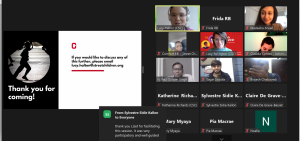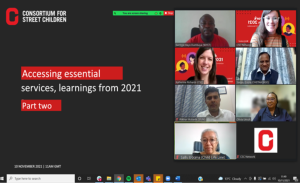From 9 to November 12, we held the second virtual edition of our Network Forum. An event where the shared learnings serve as a space to reflect on what we have achieved in the previous year, and encouragement for the projects we have for the new year.
On November 9, we kicked off our forum with an inaugural message from our Chief Executive, Pia Macrae. We were able to look at all the events that have marked the network over the last year. Even with the pandemic being a significant factor, network members continued their courageous work for street children, with adjustments or modifications throughout the regionsaffected by new variants of covid or social shocks.
After the video containing our network members projects premiered, we had our first Maggie Eales and Roger Hayes Memorial Lecture delivered by Nigel Cantwell on alternative care. After the most recent Day of General Discussion (DGD) on the theme of children’s rights and alternative care this is a topic that we are keen to deepen and broaden the dialogue on what constitutes quality of care. We were deeply honoured to have Nigel as a speaker as his experience as an expert on alternative care was helpful for both new and old network members.
We then held the first of two introductory sessions on CSC. In these sessions, moderated by CSC Senior Programme and Network Officer Lucy Rolington, members were given space to introduce themselves and plenty of opportunities to talk and exchange views on what they felt were the most pressing challenges they have faced recently. In a very organic way, members shared their shared strengths and areas for improvement and their expectations of CSC in networking and upcoming plans.
To conclude the first day, the storytelling session presented a contrast of using the same methodology- storytelling – in different regions of the world. Researchers from CLARISSA team based in Nepal and Bangladesh shared more about the adaptations made during the pandemic to engage children in storytelling; while Juconi Mexico showed us their experience using this research methodology with digital platforms. All speakers agreed that it is crucial that street children are part of the design of interventions and are consulted when carrying out actions designed for them.
The second day started with discussing the women and girls working group, which shared the progress achieved one year after its launch. Here we learned that the organisations involved have built a space where they can reflect on their work with girls; among the positive results of the group has been the awareness that women’s realisation of their rights also inspires the younger generation as part of the local communities’ empowerment.
Continuing with the theme of providing specialised services, the second session of the day was moderated by Katherine Richards, CSC Director of Programmes and Advocacy. In this session, five members of the CSC network presented details of their actions in their communities to provide street children with access to quality education and services. Three speakers gave their views on the lessons learned from more than a year of frontline work with street children, and two shared the activities they are taking to advocate for street children’s rights. It was a session where advice and words of encouragement were in abundance, reflecting that CSC is a community network where similar conditions are experienced.
To conclude the day, Monica Thomas, together with the team that has overseen the testing phase of the platform ‘Digitally Connected Street Children’, launched the redesigned platform. During the session, network members were able to have their first appreciation of the new platform and learn about the background process before it becomes available in early 2022 to the wider network. This new version aims to make the platform even more user-friendly. Street-connected children will have the opportunity to interact with the content more directly, and the workshops are designed with their feedback in mind.
On the penultimate day of the forum, Beth Plessis, CSC Head of Funding, led the session on funding advice for organisations, one of the most attended sessions. Together with three fundraising experts, they reviewed fundraising trends after a year of the pandemic crisis and what practices have and have not worked for street children’s organisations when it comes to securing funding. Lynne Morris, CEO of Toybox, added that when it comes to collecting money,
‘individuals should feel confident, joyful and hopeful, as it is a rewarding activity and should never be a source of shame’
 Victoria Burch led the second practice session of the day. After a dynamic introduction by Vicky Ferguson. The participants expressed what they saw as symptoms of trauma suffered by the street children, such as drug misuse and dropping out of education. The session gave us an insight into how to identify PTSD in street children. To prevent harmful attitudes in adulthood, it is recommended that those working with street-connected children take part in mental health training and look after their mental health while helping street children heal. It is essential to establish an honest and trusting relationship with the children to understand their ability to heal and overcome the harmful attitudes that interfere with healthy development.
Victoria Burch led the second practice session of the day. After a dynamic introduction by Vicky Ferguson. The participants expressed what they saw as symptoms of trauma suffered by the street children, such as drug misuse and dropping out of education. The session gave us an insight into how to identify PTSD in street children. To prevent harmful attitudes in adulthood, it is recommended that those working with street-connected children take part in mental health training and look after their mental health while helping street children heal. It is essential to establish an honest and trusting relationship with the children to understand their ability to heal and overcome the harmful attitudes that interfere with healthy development.
On Friday, the last day of the forum, we opened the conversation on the role street workers play in encountering street-connected children. They are expected to act with a high level of professionalism. However, attendees highlighted that they are often the ones who receive the least attention and recognition. The social workers enable a reduction of stigma and discrimination and allow children to reach their potential; therefore, frontline workers must be recognised with dignity by governments and given the support they need to carry out their work. It is necessary to make the work of street workers count so that it resonates with everyone. As speaker Helder Luiz Santos pointed out,
‘Street workers have a common identity despite different contexts; therefore, the sector needs to demonstrate the value of street work.’
This is a conversation CSC looks forward to continuing during the International Day for Street Children 2022 and beyond.
Before the closing session, Lucy Halton, CSC Legal and Advocacy Officer, was joined by fellow advocates to talk about the importance of collaboration between different actors in achieving advocacy goals. All speakers highlighted how important it is to establish a network of organisations working with street children’s rights to strengthen their advocacy and why collaboration between civil society actors is so important in child rights advocacy at the international level. As Sr., Olivia Umoh, director of Safe Child Advocacy, shared during a breakout room:
One key benefits of Advocacy is that we are stronger together’ and when spider webs unite, they can tie up a lion”
To close the forum, on November 12, our Chief Executive thanked the attendees for being part of four days of enriching conversations before summarising the key moments of each session. She added that ‘even though we work in an area guided by General Comment 21, the differences of acting at the national level is what we must be aware of.
‘Paying attention to other members makes it possible for us to learn how to innovate and deliver the specialised services that street children deserve’
In short, the members’ forum served as a reminder that we are a growing community (nearly 200 members worldwide) focused on making street children visible and that needs each other to achieve meaningful change.
We are very excited to introduce what we have learned into our plans for the year ahead. We look forward to meeting again in 2022 to listen carefully to the stories and experiences of our members around the world. We thank all those who participated in the forum: guest speakers, attendees, partners, and team members: you made it possible for the forum to be more inclusive than ever before.
To continue supporting our member’s unique community, have a look at our latest fundraising challenge that seeks to make the realities of street girls visible
To see the recordings of the sessions, visit our youtube page here.
